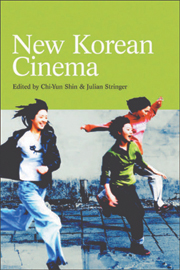Book contents
- Frontmatter
- Contents
- Notes on the Contributors
- List of Illustrations
- Introduction
- Part I Forging a New Cinema
- 1 Contemporary Cultural Production in South Korea: Vanishing Meta-Narratives of Nation
- 2 The Korean Film Industry: 1992 to the Present
- 3 Globalisation and New Korean Cinema
- 4 Chunhyang: Marketing an Old Tradition in New Korean Cinema
- 5 ‘Cine-Mania’ or Cinephilia: Film Festivals and the Identity Question
- Part II Generic Transformations
- Part III Social Change and Civil Society
- Glossary of Key Terms
- Bibliography of Works on Korean Cinema
- Websites
- Index
2 - The Korean Film Industry: 1992 to the Present
from Part I - Forging a New Cinema
Published online by Cambridge University Press: 05 August 2013
- Frontmatter
- Contents
- Notes on the Contributors
- List of Illustrations
- Introduction
- Part I Forging a New Cinema
- 1 Contemporary Cultural Production in South Korea: Vanishing Meta-Narratives of Nation
- 2 The Korean Film Industry: 1992 to the Present
- 3 Globalisation and New Korean Cinema
- 4 Chunhyang: Marketing an Old Tradition in New Korean Cinema
- 5 ‘Cine-Mania’ or Cinephilia: Film Festivals and the Identity Question
- Part II Generic Transformations
- Part III Social Change and Civil Society
- Glossary of Key Terms
- Bibliography of Works on Korean Cinema
- Websites
- Index
Summary
In 1992, as South Koreans looked towards a new future without their hated military government, the local film industry found itself at a similar crossroads. On the one hand, changes in the political sector were promising the birth of a freer society. For socially conscious film-makers, such as Jang Sun-woo (Chang Sŏn-u), Park Kwang-su (Pak Kwang-su) and Im Kwon-Taek (Im Kwŏ n-t'aek), this meant a new-found freedom to explore themes and ideas that had been banned for decades. In the coming years, films such as Park Kwang-su's To the Starry Island (Kŭ sŏme kago ship'da, 1993), which touched on atrocities committed during the Korean War (1950–53), and Jang Sun-woo's A Petal (Kkonnip, 1996), concerning the 1980 Kwangju massacre, would put a new perspective on Korean history and society.
Nonetheless, in 1992 film producers and investors housed in the offices of Ch'ungmuro (a street which formed the Korean film industry's traditional hub, and a byword for the industry) were gripped with the fear that local cinema was about to vanish. Many film companies were going out of business. The percentage of ticket sales accounted for by local films was reaching all-time lows (18.5 per cent in 1992, and 15.9 per cent in 1993). A lack of investors meant that fewer and fewer movies were being made. Most ominously, the local film market which, like that of China, had long enacted strong barriers to foreign imports, had just been forced open.
- Type
- Chapter
- Information
- New Korean Cinema , pp. 32 - 50Publisher: Edinburgh University PressPrint publication year: 2005



